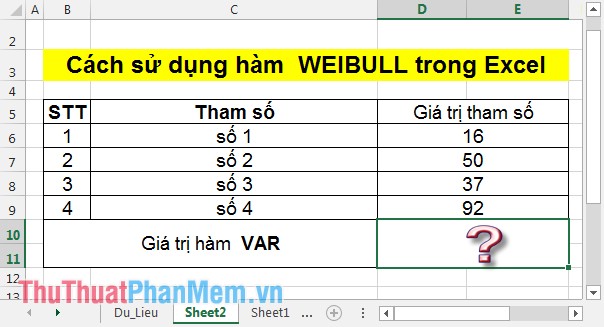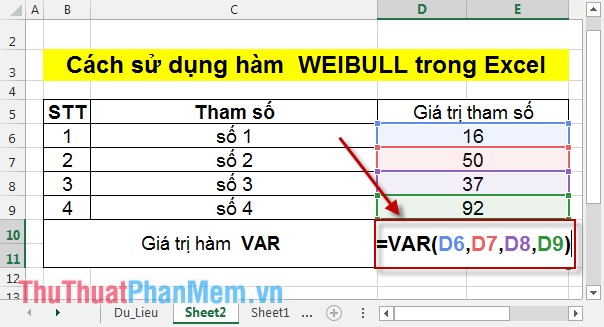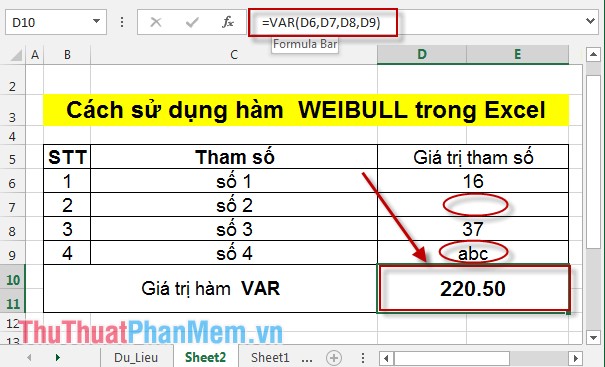VAR function - The function of estimating variance based on a sample in Excel
The following article shows in detail how to use the VAR function, the function of estimating variance based on a sample.
Description: The function performs an estimate of the latter based on a sample from a given set. Function arguments can be numbers, names or arrays, or references containing numbers.
Syntax : VAR (number 1, [number 2], .) .
Inside:
- number 1 : The first numeric argument corresponding to the overall sample, is a required parameter.
- [number 2], . : Are numerical arguments from 2 -> 255 corresponding to a sample of the set, which is an optional parameter.
Attention:
- Because the VAR function assumes that the arguments are a sample of the population, if the data is a collection then use the VARP function to calculate variance.
- Function arguments can be numbers, names, arrays, or references that contain numbers.
- Where arguments are arrays or references of new values or references are counted while logical values, text, and blank values are ignored.
- Arguments that are text or error values that return an error value because they cannot be converted to numeric types.
- If you want to use logical values and present numeric text into a reference to calculate need to use additional VARPA function .
- Equation of the VAR function :

Inside:
- x is the sample mean AVERAGE (number 1, number 2, .).
- n is the sample size.
For example:
Calculate the value of the VAR function with the following parameters:

In the cell to calculate enter the formula: = VAR (D6, D7, D8, D9) .

Press Enter -> VAR result value is:

Where the parameter is a blank value or not a numeric form -> parameter is ignored:

Above is how to use and some notes when using the VAR function , hope to help you.
Good luck!
You should read it
- STDEVA function - The function of estimating standard deviations based on a sample including both text and logical values in Excel
- VARA - Function that calculates variance based on a sample, including logical values and text in Excel
- VARP function - Functions for calculating variance based on an entire population in Excel
- VAR.P function - Function that calculates variance based on the entire set, ignoring logical values and text in Excel
- STDEV.S function - The function returns the standard deviation based on a sample in Excel
- STDEVPA function - The function of estimating standard deviations based on an entire population including both text and logical values in Excel
- VARPA function - Function that calculates variance based on the entire set, including logical values and text in Excel
- How to use the SUMIF function in Excel
May be interested
- How to use the SUMIF function in Excel
 the sumif function in excel is a function used to compute values in a specified range. the sumif function can be used for summing cells based on the date, data and text that are connected to the specified area.
the sumif function in excel is a function used to compute values in a specified range. the sumif function can be used for summing cells based on the date, data and text that are connected to the specified area. - Basic Excel functions that anyone must know
 the basic functions in excel such as the excel function, the excel statistics function we summarized below will be very helpful for you who often have to work on excel spreadsheets, especially in the field of accounting. let's refer to offline.
the basic functions in excel such as the excel function, the excel statistics function we summarized below will be very helpful for you who often have to work on excel spreadsheets, especially in the field of accounting. let's refer to offline. - ZTEST function - Returns the probability value on one side of the z test in Excel
 ztest function: the function returns the one-sided probability value of the z test. for the hypothetical population mean, the function returns the probability that the sample mean will be greater than the sample mean observed in the data set or array.
ztest function: the function returns the one-sided probability value of the z test. for the hypothetical population mean, the function returns the probability that the sample mean will be greater than the sample mean observed in the data set or array. - How to use MAXIFS function in Excel 2016
 maxifs function in excel is a statistical function that returns the largest value based on one or more conditions from the specified cells. maxifs function was introduced in ms excel 2016.
maxifs function in excel is a statistical function that returns the largest value based on one or more conditions from the specified cells. maxifs function was introduced in ms excel 2016. - DAYS360 function - The function returns the number of days between 2 dates, based on 360 days in Excel
 days360 function: the function performs the calculation of the number of days between 2 days, based on 360 days year (from 12 months, 30 days per month). useful function in calculating payments in the accounting system based on twelve months 30 days. syntax: days (start_date, end_date, [m
days360 function: the function performs the calculation of the number of days between 2 days, based on 360 days year (from 12 months, 30 days per month). useful function in calculating payments in the accounting system based on twelve months 30 days. syntax: days (start_date, end_date, [m - STDEV.P function - The function returns the standard deviation based on the whole in Excel
 stdev.p: the function returns the standard deviation based on the whole population, ignoring logical values and text. standard deviation is a measure of the dispersion of values against the mean. support functions from excel 2010 onwards. syntax: stdev.p (number1, [number2] ,.
stdev.p: the function returns the standard deviation based on the whole population, ignoring logical values and text. standard deviation is a measure of the dispersion of values against the mean. support functions from excel 2010 onwards. syntax: stdev.p (number1, [number2] ,. - How to use Hlookup function on Excel
 hlookup function basically also has the function syntax and features like vlookup function, which is to help users find data in excel table, with the conditions or given information. here is the guide for using the hlookup function in detail.
hlookup function basically also has the function syntax and features like vlookup function, which is to help users find data in excel table, with the conditions or given information. here is the guide for using the hlookup function in detail. - How to use the SUM function to calculate totals in Excel
 sum is a popular and very useful excel function, and is also a basic arithmetic function. as its name suggests, the sum function is used to calculate totals in excel. and the parameters can be single parameters or ranges of cells. in this article, tipsmake.com will guide you to use the sum function to calculate the sum in excel, the common errors when calculating sum by sum and how to fix it.
sum is a popular and very useful excel function, and is also a basic arithmetic function. as its name suggests, the sum function is used to calculate totals in excel. and the parameters can be single parameters or ranges of cells. in this article, tipsmake.com will guide you to use the sum function to calculate the sum in excel, the common errors when calculating sum by sum and how to fix it. - DATE Function: Converts numbers to a valid date format
 the date function in excel is a useful and most commonly used function. let's learn how to use the date function in excel with tipsmake.com.com!
the date function in excel is a useful and most commonly used function. let's learn how to use the date function in excel with tipsmake.com.com! - DEVSQ function - The function returns the sum of squares of deviations of data points from the sample mean in Excel
 devsq function: returns the sum of squares of deviations of data points from the sample mean. syntax: devsq (number1, [number2], ...)
devsq function: returns the sum of squares of deviations of data points from the sample mean. syntax: devsq (number1, [number2], ...)










 VARP function - Functions for calculating variance based on an entire population in Excel
VARP function - Functions for calculating variance based on an entire population in Excel PERCENTILE function - The function returns the kth percentile in Excel
PERCENTILE function - The function returns the kth percentile in Excel PERCENTRANK function - The function returns the rank of the value in Excel
PERCENTRANK function - The function returns the rank of the value in Excel POISSON function - The function returns the Poisson distribution in Excel
POISSON function - The function returns the Poisson distribution in Excel STDEV function - The function of estimating standard deviations based on a sample in Excel
STDEV function - The function of estimating standard deviations based on a sample in Excel AMORDEGRC function - The function returns the depreciation for each accounting period in Excel
AMORDEGRC function - The function returns the depreciation for each accounting period in Excel